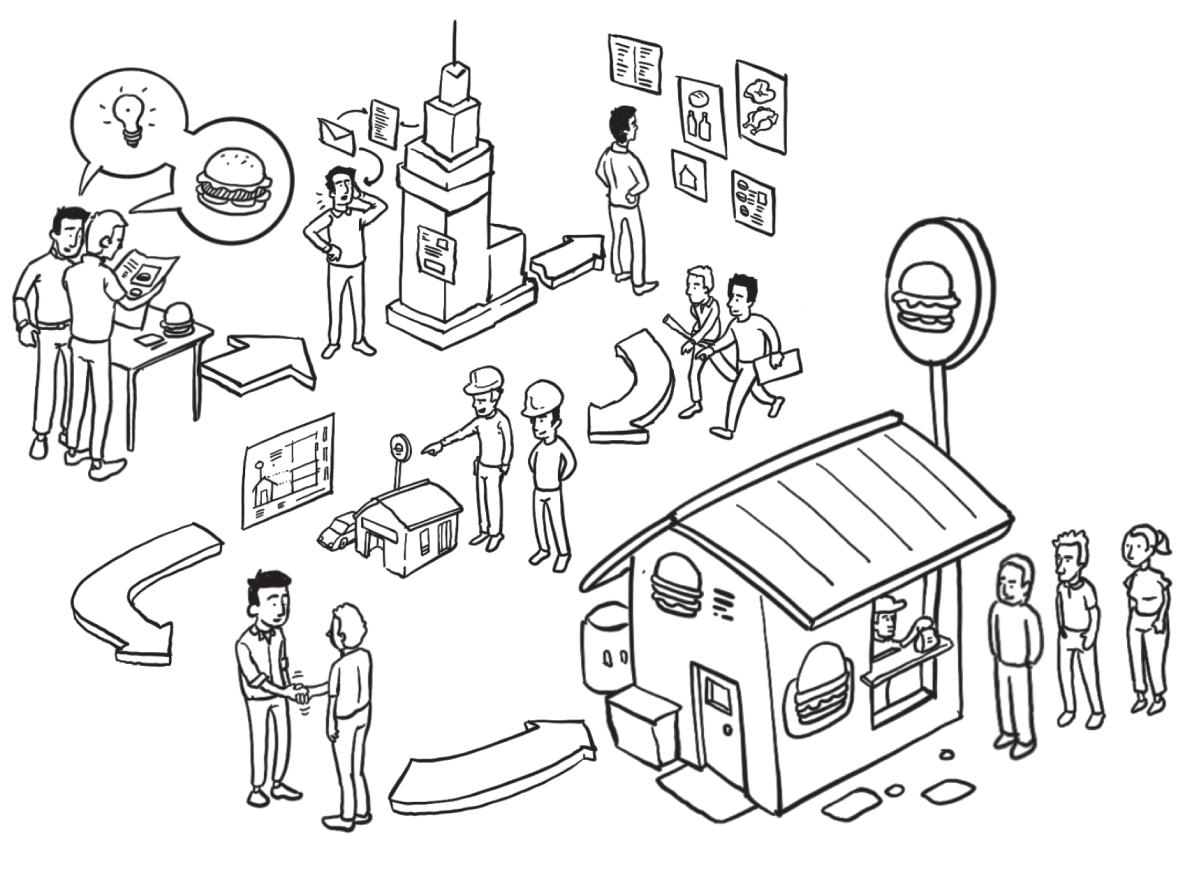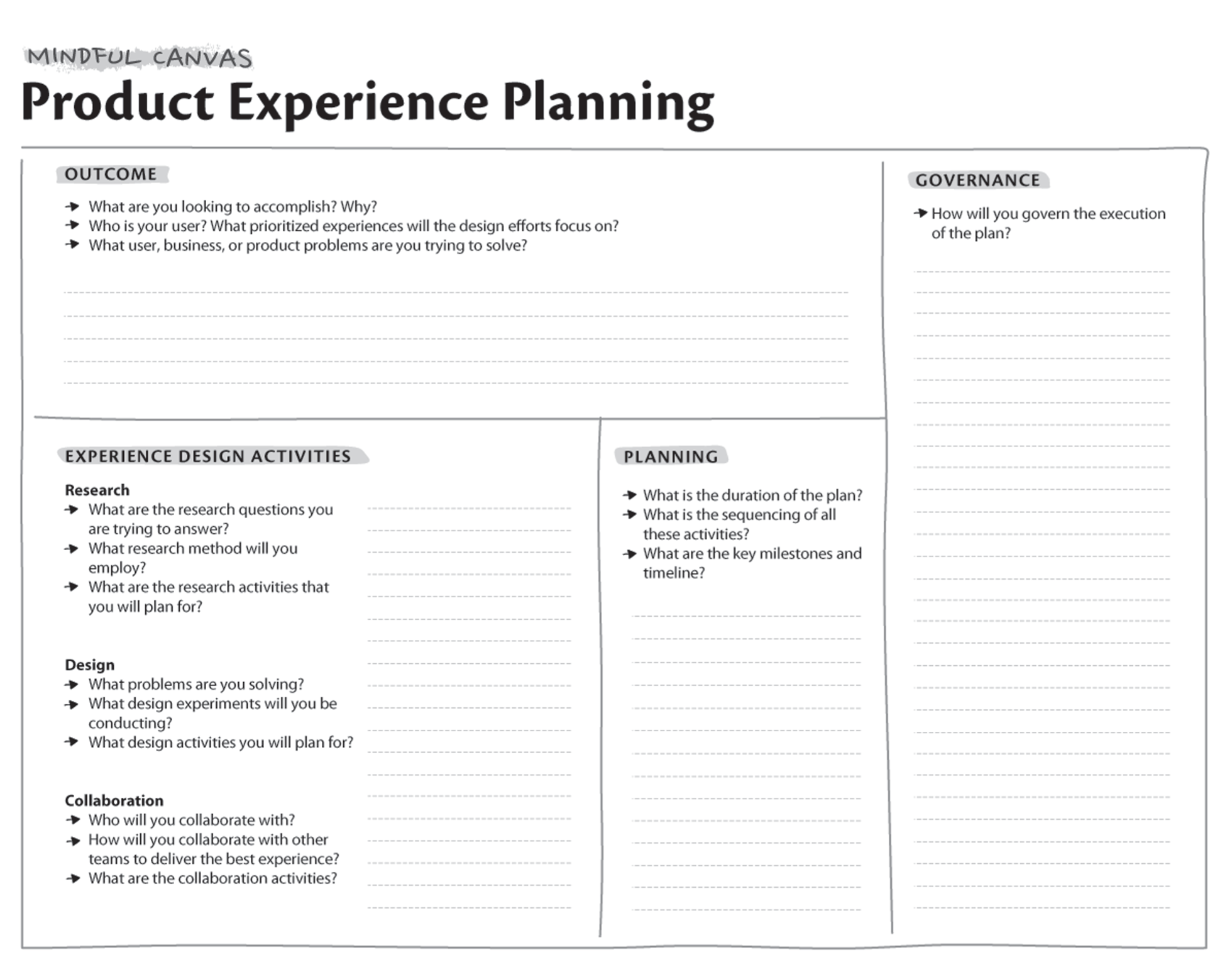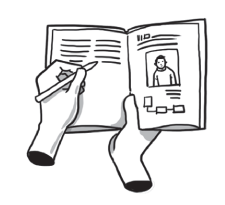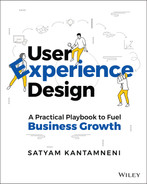CHAPTER 35
PRODUCT EXPERIENCE PLANNING PLAY: How do I ensure the delivery of a great product experience?
Product experience planning is an essential navigational tool that guides experience practitioners from a robust understanding of the product, business, and user intent, to a finished design that is ready to be handed off to the engineering team.
Time invested developing and aligning with stakeholders on the plan will pay off handsomely down the road. The resulting product experience plan is a powerful risk mitigation tool for your business, ensuring your product will launch on time and on budget.

Who Are the Key Players in the Product Experience Planning Play?
| ROLE | WHO’S INVOLVED | RESPONSIBILITIES |
|---|---|---|

DRIVER |
|
|

CONTRIBUTOR |
|
|

THE HOW
To build an effective product experience plan, you need to be mindful of:
1. Aligning to the End OUTCOME
A product experience plan is a project management play that the experience strategist develops, manages, and governs during the product thinking phase and before any design activities start. Before spending any time building the plan, it’s critical to have a crystal clear picture of your destination and answer the following questions:
- Who is the user? What prioritized product experiences will the design efforts focus on?
- What does the design aim at accomplishing? And why?
- What user, business, or product problems am I trying to solve?
Visualize the end outcome. More often than not, the goal is to achieve a vision, solve a pain point the user is currently experiencing, or deliver an enhanced experience through your product. Clearly articulate and align on what it is you are looking to achieve.
2. The EXPERIENCE DESIGN ACTIVITIES
User research activities need to be effectively factored into the plan, both to ensure that the relevant user problems are being addressed, and to mitigate the risk of designing ineffective solutions for those problems. There are a number of different research methodologies (Chapter 25: “Picking a Research Method Play”); pick the methods that are most appropriate for the outcome you are looking to achieve. Based on the chosen method include the related research activities into your product experience plan:
- Study plan: a summary of the research plan, logistical requirements, timeline, and team members involved;
- User recruitment: identifying suitable research participants and creating screener questions;
- Research study: the actual user research designed to achieve your research objective;
- Synthesis: an analysis of all types of user data consolidated into actionable insights;
- Presentation: a summary that highlights research insights and recommendations.
In a highly efficient research organization, user research typically takes three to five weeks of active research activities. However, there are two unique scenarios that you may want to plan for by budgeting in additional time:
- Recruitment for formative research often takes much longer than expected, so plan for an additional three to four weeks to recruit and screen research participants.
- If you are conducting research that involves stimuli (i.e. artifacts that will be shown to the participants), then plan for an additional three to four days to prepare and package the stimuli.
Design activities typically consist of problem identification and framing, concept generation, ideation, prototyping, validation, hand‐off, and QA.
Consider the following sample of design activities for inclusion in your product experience plan:
- Discovery: Outline the problem space, outcomes, scope, timeline, and key learnings, providing enough evidence for what to do next. Include this activity in your plan if you don’t understand the product, business, or the problem space.
- Ideation: Gather inspirations and generate ideas through collaborative sessions to address the design problem or design opportunity statements. This is a critical activity because it forces you to frame the problem, allowing you to start your design process with alignment and focus (Chapter 34: “Design Problem and Opportunities Play”).
- Workflow, Wireframe, and Iteration: Begin the iterative design process by outlining the paths of a potential user, creating a visual guide that represents the skeletal framework of a website or application, and iterating the design based on feedback. Make sure you budget for at least three rounds of iterations—one for the first draft, one for after user research and validation, and one with the final approver.
- Content and Visual Design: Specify the details of the visual style and copy that will go in the product experience.
- Prototyping: Transform the proposed solution into an interactive model for testing the designs.
- Validation: Review the final prototypes with stakeholders to ensure that the proposed solution achieves the overall business objective and meets user requirements.
- Hand‐offs: Transfer the designs to the responsible team with detailed documentation and interaction notes.
- Quality Assurance (QA): Assess the usability of the implemented design with users in order to identify potential challenges before releasing it to the market.
Your timeline will vary based on the scope of the project and your team’s resource availability. So plan your roadmap accordingly.
Generally, the end‐to‐end design cycle takes 18 weeks (22 weeks if you plan to conduct summative testing).
Finally, collaboration is key to experience design. Planning collaborative activities is often overlooked, causing significant churn in the planned process. The following collaboration activities bring together different sets of stakeholders from business, design, product, and engineering teams across different types of activities.
- Problem definition and alignment: Define the right problem to solve by considering varied perspectives from across the organization. Align on the final problem statement, outcome, and approach.
- Ideation: Generate ideas throughout the design cycle. Bring together diverse and relevant stake‐holders to generate ideas from multiple perspectives.
- Validation: Sign off on key decisions or artifacts such as the research and business objectives, user insights, and requirements.
- Reviews: Provide feedback and ensure the design outcome has been aligned with the original user, business, or product intent.
- Hand‐offs: Hand over key deliverables, insights, and clear documentation to the next team.
Collaboration activities typically take about two weeks to complete. However, you need to make sure that they are interspersed across the product experience plan.
3. PLANNING and Documenting Your Activities
After identifying the different activities that need to be considered for the product experience plan, build a three‐month forward‐looking plan, adapted if necessary for agile software development or another approach.
Include these key elements:
- Sequencing: Arrange the activities in a particular way that takes into account the relationships that exist between activities. Every activity and its sub‐activities should be staggered such that outcomes inform the next activity. This will help you avoid major roadblocks.
- Timelines: Define the durations for each activity, grouping them to make the forward‐looking plan manageable and realistic. Make sure these durations are acknowledged by all involved parties, or else the plan will inevitably fail and the project will be delayed.
- Milestones: Call out the specific intermediate milestones and checkpoints, such as reviews, ideations, hand‐offs, accountability checks, and validations, that will enable a smooth and seamless product experience process.
4. Building Proper GOVERNANCE during the Execution
Governance provides the necessary oversight to ensure activities are being executed according to plan. The experience strategist owns the responsibility of maintaining a healthy plan and conducts regular syncs with key stakeholders through activities like weekly stand‐ups and monthly planning. This ensures that everyone has clear visibility into the progress of the plan and proactively communicates potential roadblocks so there’s ample time for risk mitigation.
IN ORDER TO MAXIMIZE THE VALUE OF THIS PLAY
- Foster a shared vision. This will help the teams focus on common goals and work together to accomplish them.
- Plan in advance. Avoid last‐minute rushes, and always have a contingency plan.
- Add buffers. Budget extra time for certain activities (i.e. research) to proactively protect the plan from being derailed by delays.
- Develop checks and balances. Make sure the plan is reviewed regularly and is adapted to account for necessary changes that better reflect the current reality.
- Take design hand‐off and QA seriously. They are critical parts of the plan that will have significant downstream impact (e.g. product delays, engineering churn) if you don’t spend the time to do it well.
 RELATED PLAYS
RELATED PLAYS
- Chapter 25: “Picking a Research Method Play”
- Chapter 34: “Design Problems and Opportunities Play”
